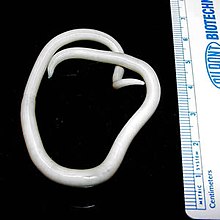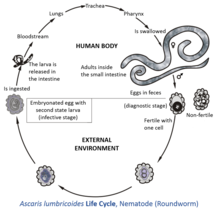Ascaris
| Ascaris | |
|---|---|

| |
| Adult female | |
| Scientific classification | |
| Domain: | Eukaryota |
| Kingdom: | Animalia |
| Phylum: | Nematoda |
| Class: | Chromadorea |
| Order: | Ascaridida |
| Family: | Ascarididae |
| Genus: | Ascaris Linnaeus, 1758 |
| Species | |
| |

Ascaris is a
Their eggs are deposited in feces and soil. Plants with the eggs on them infect any organism that consumes them.
Morphology
- Adult: cylindrical shape, creamy white or pinkish in color
- Male: average 15–30 centimetres (5.9–11.8 in); more slender than the female
- Female: average 20–35 centimetres (7.9–13.8 in)
The body is long, cylindrical, and fusiform (pointed at both the ends). The body wall is composed of
Defense mechanism
As part of the parasite defense strategy, Ascaris roundworms secrete a series of inhibitors to target digestive and immune-related host
History
Ascaris has been present in humans for at least several thousand years, as evidenced by Ascaris eggs found in paleofeces and in the intestines of mummified humans.[7]
A. lumbricoides was originally called Lumbricus teres and was first described in detail by Edward Tyson in 1683.[8] The genus Ascaris was originally described as the genus for Ascaris lumbricoides by Carl Linnaeus in 1758.[9] The morphologically similar Ascaris suum was described from pigs by Johann August Ephraim Goeze in 1782.[9]
Gallery
-
Male Ascaris cross section 200x
-
Esophagus of an Ascaris worm
-
Ascaris cross section 40×
-
Ascaris cross section 40×
-
Ascaris cross section 400×
See also
- List of parasites (human)
References
- ISBN 978-0-12-415915-0. Retrieved 19 November 2015.)
{{cite book}}: CS1 maint: multiple names: authors list (link - ^ "Parasites-Ascariasis". Centers for Disease Control and Prevention. Retrieved 30 May 2013.
- PMID 18289159.
- S2CID 27755528.
- PMID 19179285.
- PMID 7922043.
- PMID 22348306.
- ISBN 978-0-9978400-1-8.
- ^ PMID 22348306.





